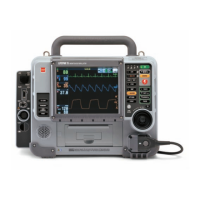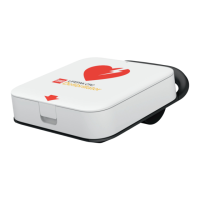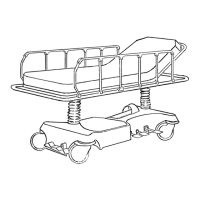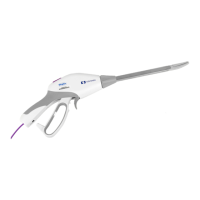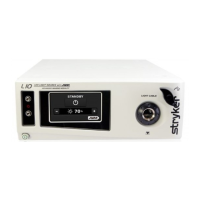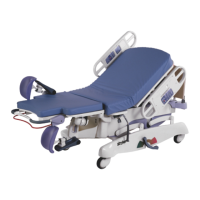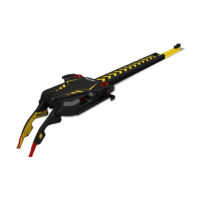Do you have a question about the Stryker LIFEPAK 1000 and is the answer not in the manual?
Explanation of defibrillation, its purpose, and related measures.
Specifies when to use the defibrillator for AED mode and ECG monitoring.
Details required skills, training, and environment for defibrillator operation.
Overview of the defibrillator's modes (AED, Manual, ECG) and key features.
Explains the use of special text characters for labels, screen messages, and voice prompts.
Definitions of terms like Danger, Warning, and Caution used in the manual.
General safety statements regarding shock, fire, explosion, and electrical interference hazards.
Explanation of various symbols used in the manual and on the defibrillator.
Introduction to the LIFEPAK 1000 defibrillator's controls and indicators with descriptions.
Details on battery charge level indicators and warning indicators.
Explanation of LED indicators on the battery charger for rechargeable batteries.
Overview of the defibrillator's operational modes: AED, Manual, and ECG.
Critical warnings and cautions related to the defibrillation process.
Detailed steps for using the defibrillator in Automated External Defibrillation (AED) mode.
Step-by-step guide for basic operation, including patient preparation and electrode placement.
Descriptions of voice prompts and screen messages guiding the user during AED operation.
Guidance on electrode placement for specific patient conditions like obesity or pacemakers.
Instructions for operating the defibrillator in Manual mode for advanced users.
Common problems and solutions encountered during defibrillation.
How to use the defibrillator for ECG monitoring and rhythm interpretation.
Solutions for common problems encountered during ECG monitoring.
Overview of storing, transferring, and reviewing patient and device data.
Explains how patient data is stored digitally and transferred to a PC.
Details the types of patient data recorded: Event Log, Continuous ECG, and CODE SUMMARY.
Information on test logs, auto-tests, power cycles, and battery replacements.
How to transmit data from the defibrillator to a PC using an IrDA port.
Recommended schedule for regular checks and maintenance of the defibrillator.
Details on internal self-tests performed by the defibrillator for readiness checks.
Instructions for routine inspection of the defibrillator, accessories, and cables.
Recommended methods and agents for cleaning the defibrillator and accessories.
Guidelines for maintaining nonrechargeable and rechargeable batteries for optimal performance.
Recommendations for preventing damage and ensuring proper storage of therapy electrodes.
Information on how to obtain service for the defibrillator, including contact details.
Guidelines for recycling the defibrillator, batteries, and electrodes according to regulations.
List of available supplies, accessories, and training tools for the LIFEPAK 1000 defibrillator.
Information on obtaining the detailed warranty statement for the defibrillator.
Details the biphasic truncated exponential waveform and its parameters.
Provides detailed electrical parameters for adult and infant/child pads.
Specifications related to AED mode, including shock advisory system and energy sequence.
Specifications for ECG display, size, type, response, and amplitude.
Details on the defibrillator's weight, height, width, and depth.
Information on memory capacity, report types, and data review capabilities.
Specifications for nonrechargeable and rechargeable batteries, including capacity and charging time.
Explanation of the ECG analysis system that advises on shock appropriateness.
How electrode contact is determined and its impact on ECG analysis and shock delivery.
Information on how the Shock Advisory System's performance was verified.
Details on the rhythms the defibrillator detects for recommending a shock.
How the system detects patient motion and its effect on ECG analysis.
Explanation of cprMAX technology for maximizing CPR during AED treatment.
How AED operation is affected by cprMAX setup options like Initial CPR and Pulse Check.
Setup option for prompting initial CPR before or after analysis/shock.
Sets the duration for the initial CPR period when enabled.
Prompts for CPR during charging when a shockable rhythm is detected.
Option to enable or disable consecutive shocks without intervening CPR.
Option to prompt for pulse checks at different stages of AED operation.
Step-by-step guide to access the defibrillator's setup menu.
Overview of the main categories for configuring device settings.
Settings for general device parameters like device ID, date/time, and audio.
Configuration options specific to AED mode operation.
Defines the defibrillation energy levels and sequences for AED mode.
Settings for CPR intervals and prompts within AED mode.
Options for pulse check prompts and AED monitoring.
Configuration options for Manual mode access and analysis.
Instructions for setting or changing the setup mode passcode.
Procedure for entering and deleting device information such as Device ID.
Checklist for routine inspection of readiness display, battery, electrodes, and supplies.
Clinical trial results comparing biphasic and monophasic shocks for VF and VT.
Comparison of biphasic and monophasic waveforms in out-of-hospital cardiac arrest.
Information on RF emissions and compliance with electromagnetic standards.
Details on immunity to electrostatic discharge, electrical transients, and magnetic fields.
Recommended distances for portable and mobile RF communications equipment.
Explanation of defibrillation, its purpose, and related measures.
Specifies when to use the defibrillator for AED mode and ECG monitoring.
Details required skills, training, and environment for defibrillator operation.
Overview of the defibrillator's modes (AED, Manual, ECG) and key features.
Explains the use of special text characters for labels, screen messages, and voice prompts.
Definitions of terms like Danger, Warning, and Caution used in the manual.
General safety statements regarding shock, fire, explosion, and electrical interference hazards.
Explanation of various symbols used in the manual and on the defibrillator.
Introduction to the LIFEPAK 1000 defibrillator's controls and indicators with descriptions.
Details on battery charge level indicators and warning indicators.
Explanation of LED indicators on the battery charger for rechargeable batteries.
Overview of the defibrillator's operational modes: AED, Manual, and ECG.
Critical warnings and cautions related to the defibrillation process.
Detailed steps for using the defibrillator in Automated External Defibrillation (AED) mode.
Step-by-step guide for basic operation, including patient preparation and electrode placement.
Descriptions of voice prompts and screen messages guiding the user during AED operation.
Guidance on electrode placement for specific patient conditions like obesity or pacemakers.
Instructions for operating the defibrillator in Manual mode for advanced users.
Common problems and solutions encountered during defibrillation.
How to use the defibrillator for ECG monitoring and rhythm interpretation.
Solutions for common problems encountered during ECG monitoring.
Overview of storing, transferring, and reviewing patient and device data.
Explains how patient data is stored digitally and transferred to a PC.
Details the types of patient data recorded: Event Log, Continuous ECG, and CODE SUMMARY.
Information on test logs, auto-tests, power cycles, and battery replacements.
How to transmit data from the defibrillator to a PC using an IrDA port.
Recommended schedule for regular checks and maintenance of the defibrillator.
Details on internal self-tests performed by the defibrillator for readiness checks.
Instructions for routine inspection of the defibrillator, accessories, and cables.
Recommended methods and agents for cleaning the defibrillator and accessories.
Guidelines for maintaining nonrechargeable and rechargeable batteries for optimal performance.
Recommendations for preventing damage and ensuring proper storage of therapy electrodes.
Information on how to obtain service for the defibrillator, including contact details.
Guidelines for recycling the defibrillator, batteries, and electrodes according to regulations.
List of available supplies, accessories, and training tools for the LIFEPAK 1000 defibrillator.
Information on obtaining the detailed warranty statement for the defibrillator.
Details the biphasic truncated exponential waveform and its parameters.
Provides detailed electrical parameters for adult and infant/child pads.
Specifications related to AED mode, including shock advisory system and energy sequence.
Specifications for ECG display, size, type, response, and amplitude.
Details on the defibrillator's weight, height, width, and depth.
Information on memory capacity, report types, and data review capabilities.
Specifications for nonrechargeable and rechargeable batteries, including capacity and charging time.
Explanation of the ECG analysis system that advises on shock appropriateness.
How electrode contact is determined and its impact on ECG analysis and shock delivery.
Information on how the Shock Advisory System's performance was verified.
Details on the rhythms the defibrillator detects for recommending a shock.
How the system detects patient motion and its effect on ECG analysis.
Explanation of cprMAX technology for maximizing CPR during AED treatment.
How AED operation is affected by cprMAX setup options like Initial CPR and Pulse Check.
Setup option for prompting initial CPR before or after analysis/shock.
Sets the duration for the initial CPR period when enabled.
Prompts for CPR during charging when a shockable rhythm is detected.
Option to enable or disable consecutive shocks without intervening CPR.
Option to prompt for pulse checks at different stages of AED operation.
Step-by-step guide to access the defibrillator's setup menu.
Overview of the main categories for configuring device settings.
Settings for general device parameters like device ID, date/time, and audio.
Configuration options specific to AED mode operation.
Defines the defibrillation energy levels and sequences for AED mode.
Settings for CPR intervals and prompts within AED mode.
Options for pulse check prompts and AED monitoring.
Configuration options for Manual mode access and analysis.
Instructions for setting or changing the setup mode passcode.
Procedure for entering and deleting device information such as Device ID.
Checklist for routine inspection of readiness display, battery, electrodes, and supplies.
Clinical trial results comparing biphasic and monophasic shocks for VF and VT.
Comparison of biphasic and monophasic waveforms in out-of-hospital cardiac arrest.
Information on RF emissions and compliance with electromagnetic standards.
Details on immunity to electrostatic discharge, electrical transients, and magnetic fields.
Recommended distances for portable and mobile RF communications equipment.
| Device Type | Automated External Defibrillator (AED) |
|---|---|
| Type | Semi-Automatic |
| Battery Type | Lithium-ion rechargeable battery |
| Shock Advisory | Yes |
| Audio Prompts | Yes |
| CPR Coaching | Yes |
| IP Rating | IP55 |
| ECG Monitoring | Yes |
| CPR Feedback | Yes |
| Display | LCD screen |
| Waveform | biphasic |
| Operating Temperature | 32°F to 122°F (0°C to 50°C) |
| Humidity Range | 5% to 95% non-condensing |
| Altitude Range | -1000 ft to 15, 000 ft (-305 m to 4, 572 m) |
| Storage Temperature | -4° to 158°F (-20° to 70°C) (without battery) |
